A Gabon NGO working to preserve the critically endangered Leatherback sea turtle and the largest Leatherback nesting population in the world.

The world is at great risk of losing the largest sea turtle species, the Leatherback turtle, as 95% of the Pacific Ocean’s Leatherback population has been lost in the last 20 years! Many factors have contributed to their now critically endangered status. An extremely 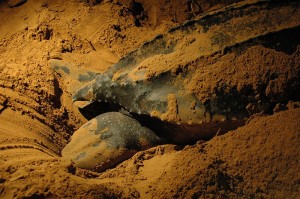 mobile animal, sea turtles cover a lot of ground (or water, in their case) between their feeding and breeding behaviors, thus using a variety of different sea habitats throughout their life cycle. In so doing, they are exposed to a large number of threats including (but not limited to) poaching of adults and nests for food and profitable parts (such as the shell), human disturbances, nest destruction from feral pigs and dogs, the effects of global warming, pollution, habitat loss, beach erosion, and industrial fisheries bycatch.
mobile animal, sea turtles cover a lot of ground (or water, in their case) between their feeding and breeding behaviors, thus using a variety of different sea habitats throughout their life cycle. In so doing, they are exposed to a large number of threats including (but not limited to) poaching of adults and nests for food and profitable parts (such as the shell), human disturbances, nest destruction from feral pigs and dogs, the effects of global warming, pollution, habitat loss, beach erosion, and industrial fisheries bycatch.
Gabon hosts the largest Leatherback nesting population in the world, with as much as 30% of the world’s population nesting on her beautiful beaches. Three other sea turtle species also nest on Gabon’s coastline: the Hawksbill, Olive Ridley, and Green sea turtles. For many years, various small programs tried to conserve the nesting sea turtle populations of Gabon, but their efforts were inhibited by lack of funding and organization. In 2005, these fragmented programs united to form the Gabon Sea Turtle Partnership. It is made up of these pre-existing programs and local and government stakeholders, believing that conservation efforts will only be successful if they involve local communities and are supported by government 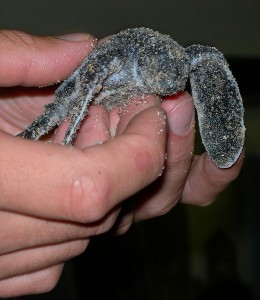 authorities. The Partnership conducts research, monitoring, surveillance, and protective measures at seven different locations in four national parks, spanning nearly 60 km of coastline.
authorities. The Partnership conducts research, monitoring, surveillance, and protective measures at seven different locations in four national parks, spanning nearly 60 km of coastline.
They seek to standardize methods used to collect data, monitor beaches, and in direct conservation actions, in order to ensure the quality and value of their data. Each highly-trained field team conducts nightly patrols looking for nesting females and potential threats, such as poachers and feral animals. They measure, tag, and collect samples from any turtles they encounter and collect data from nests and hatchlings. They proactively address all threats to sea turtles’ survival, including things like erosion, artificial lighting influences, pollution, oil spills, inappropriate beach use, and illegal fisheries. Three aerial surveys are conducted each nesting season to quantify the number and distribution of sea turtles nesting on Gabon’s beaches, and also to assess coastal threats. Info acquired can also assist Gabonese authorities with management. The organization has a substantial outreach program that educates people of all types and ages about sea turtle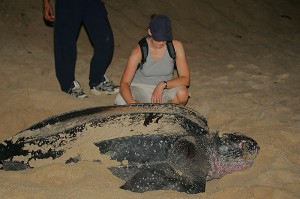 conservation. They focus their efforts on coastal communities living in or near the national parks, visitors of national parks, and the people residing in Gabon’s capital, Libreville, who do not get to experience Gabon’s rich ecosystems.
conservation. They focus their efforts on coastal communities living in or near the national parks, visitors of national parks, and the people residing in Gabon’s capital, Libreville, who do not get to experience Gabon’s rich ecosystems.
They strive to instill a sense of stewardship and responsibility for Gabon’s natural heritage. The Partnership conducts many seminars, presentations, tours, and informal discussions, and also produces and distributes educational materials. They utilize a unique form of raising awareness and education with a role-playing program complete with handmade sea turtle, jellyfish, and crab costumes. A highly-informative, mobile sea turtle exhibits helps them spread their message around the country, and a permanent exhibit is in 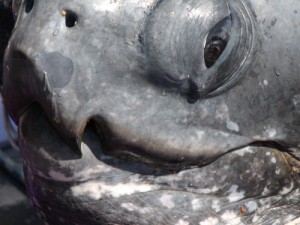 planning. The organization expands their outreach efforts to a global scale, realizing that their work may prove futile because of lack of protection and conservation practices in other areas of the world that contain habitats used by the same turtles that nest in Gabon. The Gabon Sea Turtle Partnerships sets an excellent example for other countries to follow in the protection and conservation of endangered sea turtles around the world.
planning. The organization expands their outreach efforts to a global scale, realizing that their work may prove futile because of lack of protection and conservation practices in other areas of the world that contain habitats used by the same turtles that nest in Gabon. The Gabon Sea Turtle Partnerships sets an excellent example for other countries to follow in the protection and conservation of endangered sea turtles around the world.
To learn more, please visit their website.
Image #1 © Gabon Sea Turtle Partnership
Image #2 by Coalicion pro CEN via Wikimedia Commons
Image #3 by Dtobias via Wikimedia Commons
Image #4 by Leviathan via Wikimedia Commons
Image #5 & 6 by Scott R. Benson, NMFS Southwest Fisheries Science Center via Wikimedia Commons

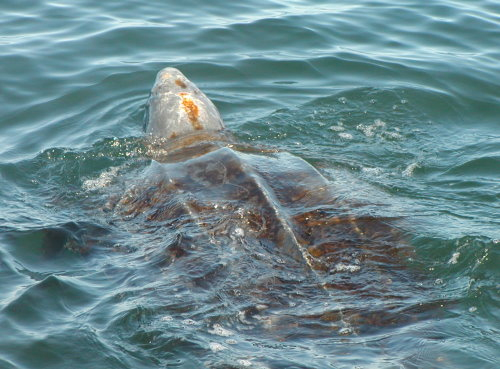


2 Responses to “In the Spotlight: Gabon Sea Turtle Partnership”